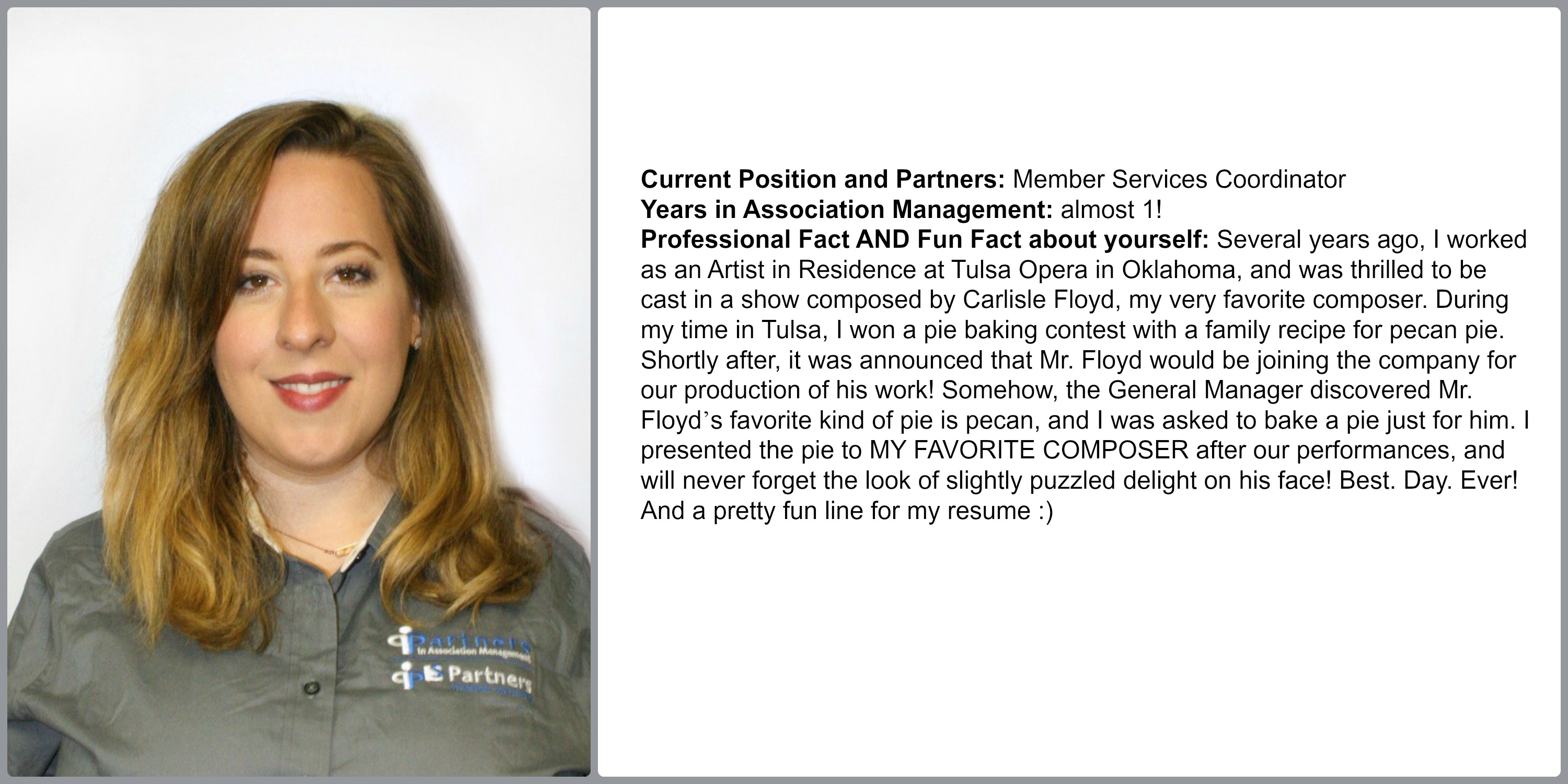By: Elizabeth Kelsay
I come from a pretty different background than most of our colleagues at Partners. For the last 10 years, I have been working in the arts as a singer at various opera houses around the US and Europe. Like many of my colleagues in the arts, I have often felt the need to explain why and measure how the arts have value.
 I have sung in some of the world’s most prestigious opera houses, and while my pocket-full of stories is delightfully heavy, things like a 401k and health insurance didn’t come my way until about 9 months ago, when I came to work for Partners. Lots of smart people have written articles about experiences like mine, but the view that makes the most sense to me can be summed up like this: In a society driven by monetary value, the arts have had a hard time maintaining a place of importance – in small communities, in large cities, in America, and across the globe. “Starving artists” have invariably found ourselves asking the BIG question: How can we serve and enrich our communities when the opportunities to do so are granted based on a system that defines worth in terms of cash-flow…and WE AIN’T GOT NONE?!
I have sung in some of the world’s most prestigious opera houses, and while my pocket-full of stories is delightfully heavy, things like a 401k and health insurance didn’t come my way until about 9 months ago, when I came to work for Partners. Lots of smart people have written articles about experiences like mine, but the view that makes the most sense to me can be summed up like this: In a society driven by monetary value, the arts have had a hard time maintaining a place of importance – in small communities, in large cities, in America, and across the globe. “Starving artists” have invariably found ourselves asking the BIG question: How can we serve and enrich our communities when the opportunities to do so are granted based on a system that defines worth in terms of cash-flow…and WE AIN’T GOT NONE?!
A man named Alan Brown has taken on this question with gusto. In his book Counting New Beans, he re-phrases the question: Using language that defines value in numeric terms, can we demonstrate to communities that they, in fact, DO value the arts? Brown goes on to define metrics for qualifying an arts organizations’ worth via the currency of intrinsic value*. Five intrinsic values are named, three of which I find particularly relevant: intellectual stimulation, emotional resonance, and social bridging and bonding. In spite of my recent career change, I harbor a predictable, yet deep desire for my experience working in the arts to remain relevant in my life, and the question that naturally follows all this moody ruminating is: Aren’t those values, like, SUPER important to Associations, too?
Through the professional development program offered to all employees at Partners, I was able to attend the African Studies Association’s 61st Annual Meeting in Atlanta. I was pumped for the following reasons:
- It would be my first experience at an association meeting of any kind
- It would be a chance to hear my boyfriend, who had been chosen as a panelist, speak on his dissertation research (exorcisms in Morocco….even weirder when you read it for the 2nd time, am I right?)
- Because the ASA is dedicated to championing arts projects that contribute to the field of African Studies, it would be a chance to see, in live action, how the arts can be incorporated into a meeting atmosphere
The meeting took place in Atlanta, a city that currently boasts one of the richest and fastest growing artistic cultures in America. The ASA did a great job of taking advantage of their location— I was thrilled to find that the New Highlife Ensemble of Morehouse College would be performing at the closing reception and would be premiering new music written specifically for the occasion. There were also scheduled “Flash Slides.” These one-minute displays were projected in the main lobby of the hotel as visually stimulating spectacles of intentionally attention grabbing content. But, what I was most interested in were what the Meetings and Events Program labeled, “Walking Panels.” These 45-60 minute tours guided participants to nearby hotspots of conference relevant cultural and artistic exhibits, and, in some cases, would be led by the artists themselves. I quickly signed up for a tour led by Atlanta based sculptor, Ruth Stanford. This experience turned out to be the highlight of the conference for me and got me excitedly scribbling ideas in the margins of my program.
Ruth Stanford had been selected by an art gallery in the African country of Zambia as an artist-in-residence. She relocated to a small community in the south of Africa for a year, with full funding for whatever she was inspired to create. A sculptor at heart, Ruth was struck by the textured patterns of footprints in the sand outside the art gallery, which was the focal point of this community’s activities. With her artful, storyteller’s eye, Ruth saw that the footprints told tales, both “real and imagined,” about their owners – the lives of the citizens were documented in the shapes they left in the sand. She began taking photos of all kinds of footprints: those left by humans, those left by birds; footprints of children and adults, men and women; those with wealth enough for shoes, and those without. The resulting images ignited my imagination and my own penchant for storytelling. I felt like I had visited this remote African village of which I had never heard. I felt a camaraderie with these artistically motivated people whom I will never meet. I wanted to be a part of the buzz of conversation that surrounded their art gallery.
By some strange twist of luck, I was the only person who signed up for Ruth’s Walking Panel. We were both a little disappointed about this at first, but it gave us a chance to get to know each other. I told her about my background as a singer, and my frustrations with the lack of funding and opportunity in the field, and she was able to commiserate on many levels. We spoke more about her artist-in-residence program. She had come to it by way of the ASA. A friend of hers was a board member, and had heard about Zambia’s desire to invest in its own unique, art-strong culture. The board member coordinated a meeting between Ruth and the gallery owners, and the residency was agreed upon. When Ruth returned to the US, the board member suggested the ASA’s 61st Annual Meeting as a site for her experience to be shared and featured. “An association provided you with the means, opportunity, and venue to introduce brand new art to this planet! This association has power!” I told her, excitedly.
If brainstorms were currency, Ruth and I could have surely become land owning yacht people that afternoon. At her prompting, I told her more about Partners and the associations we manage. In speaking about the arts and associations, we asked, “What makes these industries unique from others? Unique from each other?” And most interesting to me, “What do they have in common?” One answer seems to be intrinsic value.
Aiming to learn more when I returned to Tallahassee, I decided my greatest resources were the knowledgeable, hardworking, passionate people sitting around me at the office. Without preamble, I posed my slightly loaded question: “In your opinion, what is intrinsic value of the associations we manage?”
- “Members of associations gain knowledge about legislation, and even more important, the advocacy that legislation inspires.” -Ricki Sexton
- “Associations serve communities: Consumers benefit from the reassurance of knowing a [member] tradesman meets a standard of training, skill, and current industry standards.” –Stephen Conliffe
- “Associations facilitate the trade of products, but more importantly, the trade of ideas.” –Alonda Hill
- “The organizational model of an association provides valuable construct to a group of people that share common skills, trades, and philosophies.” – Malarie Barineau
- “An association is an entity that becomes greater than the sum of its parts: it is a source of knowledge, available to all its members.” – Lesli Sullivan
These heartwarming, thoughtful responses speak to an association’s ability to offer intellectual stimulation, emotional resonance, and social bridging and bonding. Like the arts, associations are hosts to pockets-full of intrinsic value. The combined forces of the two enabled Ruth’s rich experience and mine. These valuable experiences are exactly the kind of new beans Allan Brown introduces in his book. I, for one, am enjoying counting them. Plus, I’m developing quite an appetite for chili!
*If, like me, you think this is pretty awesome, please read this book: Brown, Allan, et al. Counting New Beans: Intrinsic Impact and the Value of Art. San Francisco, CA: Theater Bay Area, 2012. Print.





